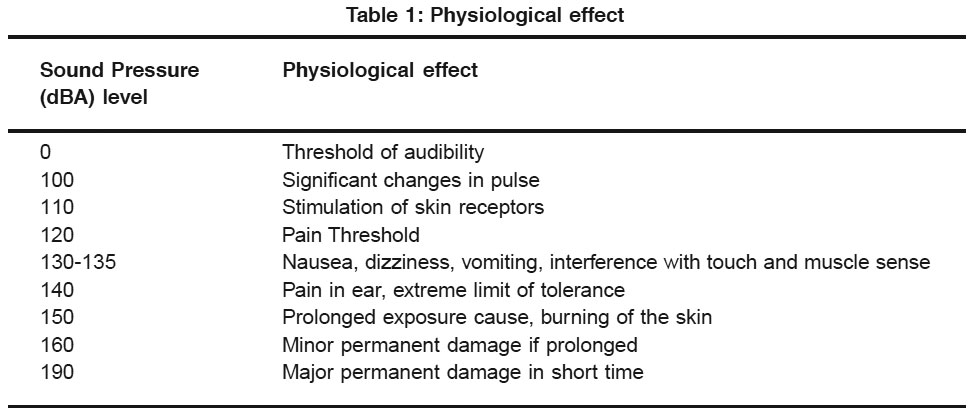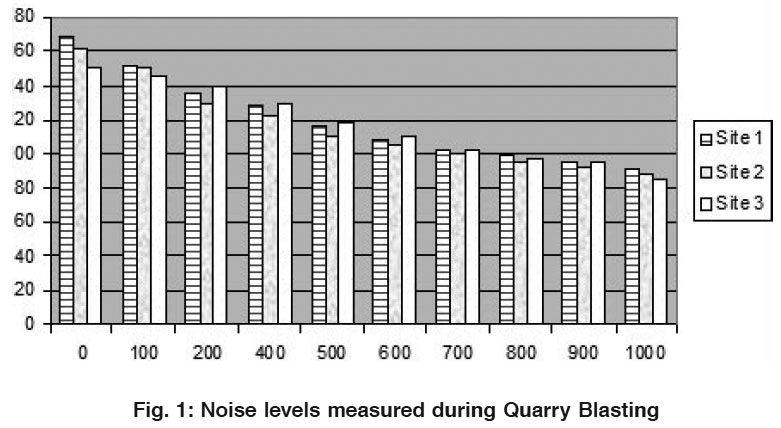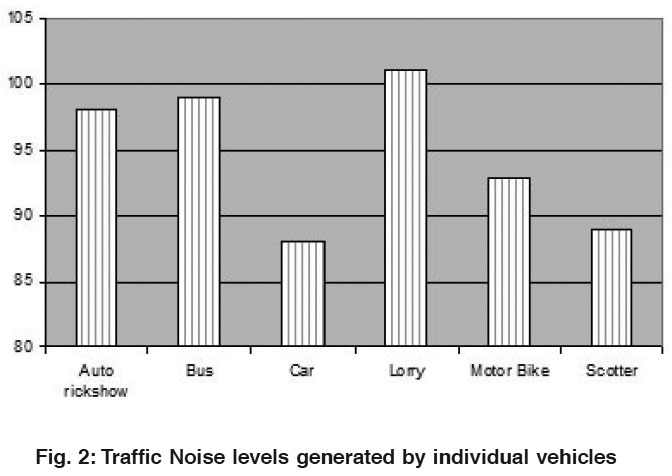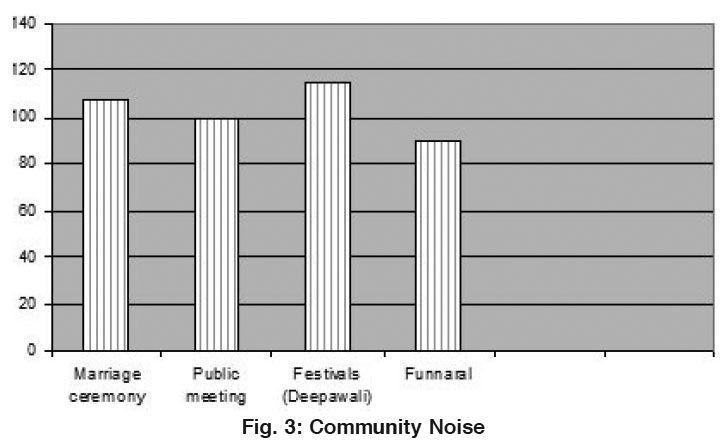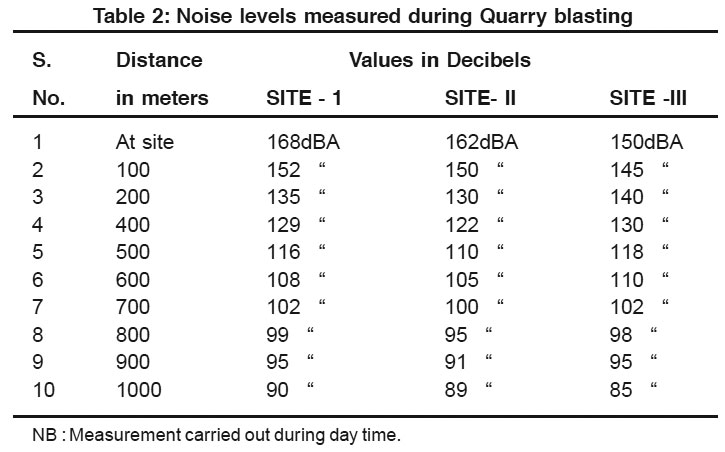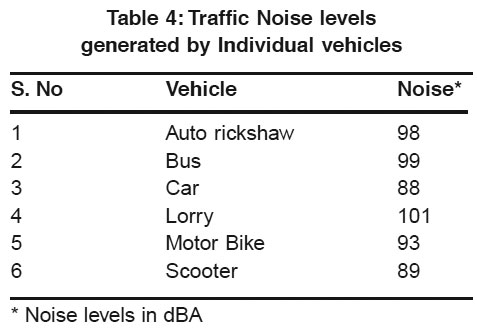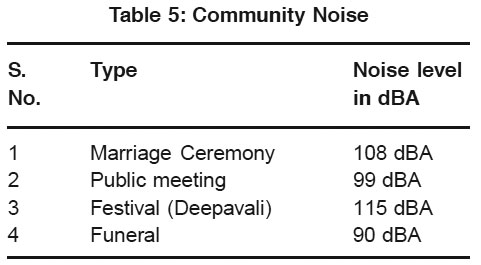Physiological ill effect of environmental pollution due to industrial developments
B.M. Kalshetty1 * , R.C. Sheth1 , M.C. Sangannavar1 and M.B. Kalashetti2
1
Department of Chemistry,
Comm. B.H.S Arts and T.G.P. Science College,
Jamkhandi,
587 301
India
2
Department of Studies in Chemistry,
Karnatak University,
Dharwad,
580 003
India
DOI: http://dx.doi.org/10.12944/CWE.5.1.26
Modern life has given rise to new form of pollution, called noise pollution. No doubt noise is a normal phenomenon of life and is deemed to be one of the most effective alarm systems in man’s physical environment. It is potentially a serious signal and grave to the environmental health. The modern civilization creates more and more noise, because of the development of industry, machinery and technology. It has been reported that noise inside the factories can become a health hazard causing deafness. The sound intensity is measured in decibel (dBA). Which is 10th part of the longest unit Bel, one dBA is equal to the faintest sound, a human ear can hear. Decibel (dBA) is ratio expressed as the logarithmic scale relative to a reference sound pressure level. The major problem around the town where facing is the quarry blasting a lot of noise affecting on the style of man kind.
Copy the following to cite this article:
Kalshetty B.M, Sheth R.C, Sangannavar M.C, Kalashetti M. B. Physiological ill effect of environmental pollution due to industrial developments. Curr World Environ 2010;5(1):159-163 DOI:http://dx.doi.org/10.12944/CWE.5.1.26
Copy the following to cite this URL:
Kalshetty B.M, Sheth R.C, Sangannavar M.C, Kalashetti M. B. Physiological ill effect of environmental pollution due to industrial developments. Curr World Environ 2010;5(1):159-163. Available from: http://www.cwejournal.org/?p=1136
Download article (pdf)
Citation Manager
Publish History
Select type of program for download
| Endnote EndNote format (Mac & Win) | |
| Reference Manager Ris format (Win only) | |
| Procite Ris format (Win only) | |
| Medlars Format | |
| RefWorks Format RefWorks format (Mac & Win) | |
| BibTex Format BibTex format (Mac & Win) |
Article Publishing History
| Received: | 2010-04-04 |
|---|---|
| Accepted: | 2010-05-30 |
Introduction
Sound pressures and physiological effect, awareness, the basic principle of noise control are education of the general pollution, effective legislation, control of noise at source and its transmission and the use of personal protective devices. The ignorant workers working in such quarry blasting.
The Central Pollutions Control Board (CPCB) has asked for a ban on all crackers with a noise level of 90dBA and above. It has also recommended that no one should be allowed burn crackers after 11.00 pm. Although, the CPCB has suggested to city authorities banning the use of crackers which register a noise of 65dBA and above at the time of explosion. Risk from Diwali pollution, formation of smog and dangerous cocktail of high levels of SO2, CO, suspended particulate matter and the metallic salts also documented.Traffic noise, people living near busy airports, Noise generated by individual vehicles reported maximum for lorries etc., 101 dBA which makes a significant changes in pulse.
The health hazards in humans due to noise pollution are of varied types. The noise pollution study will be carried out in Rabakavi-Banahatti both are urbanizing town of Bagalkot district in Karnataka state. Noise should be measured by using a micro phones in selected areas. The noise causing in marriages, funerals, festivals, Public meeting and individual vehicles like lorry ,bus, autorikshow, scooter and Car are to be measured. Recommendations are given to quarry blasting personnel’s.
Rabakavi-Banahatti are two urbanizing towns, are known for automatic loom industries (works). These two towns situated in the North West periphery of Bagalkot district of Karnataka State.
|
Table 1: Physiological effect
Click here to view table |
Towns are placed 3000-3200 feet above sea level on state high way and are situated about 20 kms from Jamkhandi and 100 kms from Kolhapur as well as Belgavi districts and are well connected by roads from Bijapur to Sangli and Poona.
The places have got a salubrious climate making sophisticated, several industries of repute like automatic loom works, cotton mills, spinning mills, gadi industries have helped in placing these two towns on the world industrial map with their best products.The development of the region consists of increasing use of resources, more job opportunities, higher income and future growth but it is causing adverse affect on the local environment, i.e., environmental pollution and human health problems.
|
Figure 1: Noise levels measured during Quarry Blasting
Click here to view figure |
Material and Methods
An attempt will be made to discuss the environmental pollution problem that arises due to rapid growth of mills and industries.It is necessary to examine the cause and consequences of noise and to explore the possibilities of reducing noise pollution.
-
Noise interferes with daily activities in three distinct levels,
-
Audiological level (saving mechanism).
-
Biological level (physiological function of the body).
-
Behavioural level (effects the sociological behaviour).
-
To provide an insight into various facts of industrial pollution.
|
Figure 2: Traffic Noise levels generated by individual vehicles
Click here to view figure |
The study of Rabakavi-Banahatti towns, urbanization and impact on environment is under taken to high light the present condition of the towns and to create awareness among industrialists, engineers, planners, administrators and common public about hazardous potentials of pollutants, so as to avert their consequences.
-
To monitor sound levels at various places.
-
To evaluate the level of pollution on the three major environmental factors air, water & noise and to suggest steps to be taken up towards pollution abatement in the urbanization of Rabakavi-Banahatti towns.
|
Figure 3: Community Noise
|
Results and Discussion
Noise is measured using a sound level meter. It is an instrument which has a microphone amplifier, weighing network and an indicating meter which gives a reading in dBA [decibel].
|
Table 2: Noise levels measured during Quarry blasting
Click here to view table |
The microphone response directly to the pressure variations in the sound field and its output is amplified to give a reading of sound pressure level directly on the meter. The weighing network superimposes frequency response on the amplifier similar to that of human ear.
|
Table 3: Noise level limits prescribed by World Health Org./ KPCB
Click here to view table |
Physiological Ill Effects of Noise Pollution
Cardiovascular system has been reported to be especially vulnerable to noise hazards. Workers exposed to high noise levels had high incidence of circulatory problems.Noise is also a cause for cardiac disease, hyper tension, and peptic ulcers.
|
Table 4: Traffic Noise levels generated by Individual vehicles
Click here to view table |
People living near airports have higher incidence of psychiatric and mental problems. Women living in this area suffer from a number of menstrual disorders.Noise induces hearing loss, higher rate of accidents and decrease in productivity in case of industrial workers.Constant high noise levels cause the blood vessels to contract, skin to become pale, muscles to constrict and adrenaline to shoot into the blood stream.
|
Table 5: Community Noise
Click here to view table |
Conclusion
Recommendations on Quarry Blasting
-
Steps should be taken to use lesser quantity of explosives and a greater time lag between consecutive blasts.
-
Blasting should be done by remote control.
-
Workers should be provided with ear plugs.
|
Table 6: Noise levels (measured) generated by spinning mill of Banahatti and Small scale industries of Rabkavi
Click here to view table |
Recommendations on Traffic Noise Control
-
Research is carried out to develop quieter type of diesel engines.
-
Routing away of highways from populated areas.
-
Noise can be baffled with Barriers.
-
Planting Avenue trees along pavements.
-
Lowering speed limits and designing for non-operations.
Recommendation on Community Noise
-
Use of Loudspeakers, Fire works should be minimized and prohibited in populated and residential areas.
-
Use of Banzos during Jatra of area should be stopped, the cooperation of the people of the community stands the best way to reduce the noise in the community.
References
-
Environmental Chemistry : B.K.Sharma, Goel Publishing House, Meerut.
-
Environmental Chemistry : A.K.De, Third Ed., New Age International (P) Limited Publishers.
-
Methods in Environmental Analysis : Water Soil and Air, P. K. Gupta, Agrobios (India) (2002).
-
Andrew Goudre, The human impact on the natural environment, Basil Blackwell Ltd., U. K., (1990) 169-179.
-
Anon, I.C.M.R., Bull, (1979) 9: 1-5.
-
Ansari Z. R., Environmental Pollution and Protection, Attar Chand, H. K. Publishers and Distributors, Delhi, (1989) 4-5.
-
Dhar B. B. and Ratan S., Chem. Age, India, (1977) 28: 847-852.
-
Godre K. C., Indian J. Env. Pollution, (1991) 2(11): 862-863.
-
Kosbekar M. S., Maharastra Med., J., (1973) 20: 25-27.
-
Madan Mohan and Rao, K.C.S., Indian J. Qcc. Health, (1983) 20: 267-273.
-
Madhusudan Rao, Noise Pollution Control Tech. and Instruments In Industrial Safety and Pollution Control hand book, (1993) 191-200.
-
Purushotam S., A Noise Survey in the Workshop of a road transport organization, CLI, Bombay, (1975) 40: 14.
-
Sinha R. K., Automobile Pollution in India and its human impact, The Environmentalist, (1993) 13(2): 111-115.
-
Srivastava A. K. and Gupta B. N., Indian J. Environmental Protect, (1998) 8(7): 481-486.
-
Watkins L. H., Environmental impact of roads and traffic, Lon. (1981) 83: 148.


